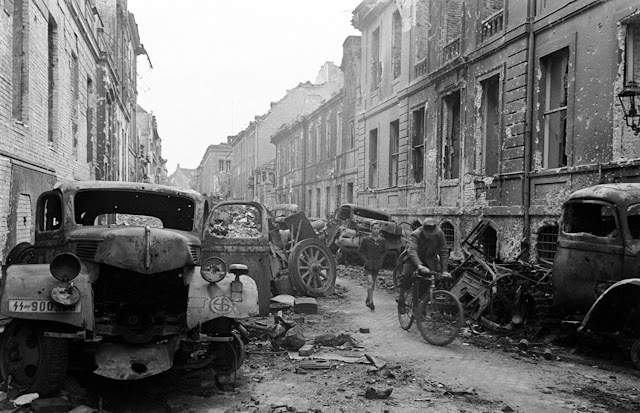After the Fall: Haunting Photographs Document the Scene Inside Hitler’s Bunker and the Ruins of Berlin.H
William Vandivert photographed for LIFE from the late 1930s through 1948. In April, 1945, as Russian and German troops fought — savagely, street-by-street — for control of the German capital, it became increasingly clear that the Allies would win the war in Europe. Not long after the two-week battle ended, Vandivert was on the scene, photographing Berlin’s devastated landscape.
Hundreds of thousands perished in the Battle of Berlin — including untold numbers of civilian men, women, and children — while countless more were left homeless in the ruins. But it was two particular deaths, that of Hitler and his longtime companion and (briefly) wife, Eva Braun, in a sordid underground bunker on April 30, 1945, that truly signaled the end of the Third Reich.
Vandivert was the first Western photographer to gain access to Hitler’s Führerbunker (translation: “shelter for the leader”) after the fall of Berlin, and a handful of his pictures of the bunker and the ruined city were published in LIFE in July, 1945. A few of those images are re-published here; most of the pictures in this gallery, however, went unpublished — until now — and illustrate the surreal, disturbing scenes Vandivert encountered in the bunker itself, and in the streets of the ruined, vanquished city beyond the bunker’s concrete walls.
  |
| Oberwallstrasse, in central Berlin, saw some of the most vicious fighting between German and Soviet troops in the spring of 1945. |
 |
| Hitler’s bunker partially burned by retreating German troops and stripped of valuables by invading Russians. |
 |
| A 16th century painting reportedly stolen from a Milan museum. |
 |
| With only candles to light their way, war correspondents examine a couch stained with blood (see dark patch on the arm of the sofa) located inside Hitler’s bunker. |
 |
| Abandoned furniture and debris inside Adolf Hitler’s bunker, Berlin, 1945. |
 |
| Papers (mostly news reports dated April 29, the day before Hitler and Eva Bruan killed themselves) inside Hitler’s bunker, Berlin, 1945. |
 |
| A Russian soldier stands in Adolf Hitler’s bunker, Berlin, 1945. |
 |
| Desk inside Adolf Hitler’s bunker, Berlin, 1945. |
 |
| An SS officer’s cap, with the infamous death’s-head skull emblem barely visible. |
 |
| A ruined, empty and likely looted safe inside Hitler’s bunker. |
 |
| In the garden of the Reich Chancellery, Berlin, 1945. |
 |
| Bullet-riddled sentry pillbox outside Hitler’s bunker, Berlin, 1945. |
 |
| An unidentified hand on the destroyed hinge of the door to Hitler’s bunker, burned off by advancing Russian combat engineers, Berlin, 1945. |
 |
| Empty gasoline cans, reportedly used by SS troops to burn the bodies of Hitler and Eva Braun after their suicides in the bunker, Berlin, 1945. |
 |
| Russian soldiers and a civilian struggle to move a large bronze Nazi Party eagle that once loomed over a doorway of the Reich Chancellery, Berlin, 1945. |
 |
| An image almost too perfectly symbolic of Berlin in 1945: A crushed globe and a bust of Hitler amid rubble outside the ruined Reich Chancellery. |
(Photos: William Vandivert—Time & Life Pictures/Getty Images)







